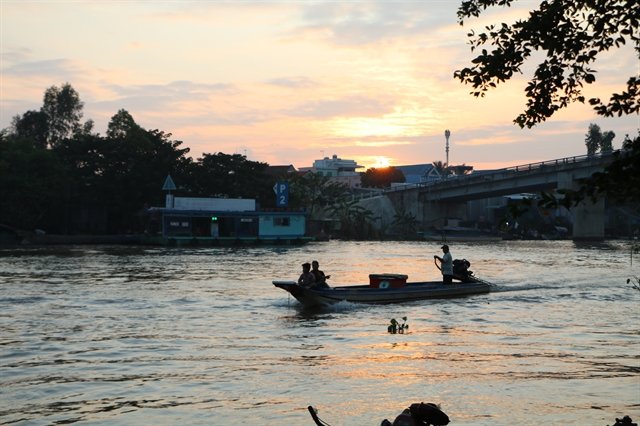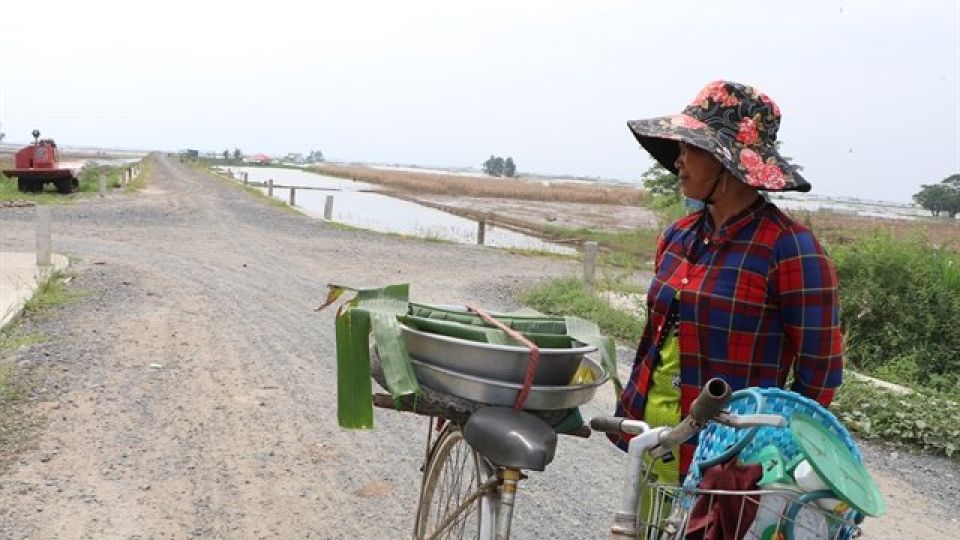March 1, 2023
HANOI – Fishing is what used to keep Nguyễn Thị Nga’s family afloat during the Mekong Delta’s flood season in the southern province of An Giang.
“We always filled buckets with fish, but now there are very few,” said the 44-year-old woman with a sigh. Money earned from selling the catch is “barely enough” to raise her three children and pay their tuition.
As climate change, upstream hydropower dams and intensive agriculture threaten traditional farming and fisheries in the Mekong Delta, women like Nga are struggling to find stable alternative livelihoods. Experts highlight their traditional gender roles and limited education and capital as hindrances to their ability to break free from a vicious cycle of vulnerability and precarity.
The rice fields in Nhơn Hội Commune, where Nga’s family live, used to be full of fish migrating from upstream during the flood season that lasts from September to November every year.
In 2000, the wild freshwater fish catch in An Giang stood at 91,270 tonnes, according to the country’s General Statistics Office, but 21 years later, that number has plummeted to 14,800 tonnes, driving thousands of fisherfolk out of their traditional livelihood.

A family of three rides a boat to buy fish from local fishermen in Nhơn Hội Commune at dawn. — VNS Photo Vân Nguyễn
Those in the fishing industry are not alone. From upstream down to the coast, farmers of the Mekong Delta have been grappling with climate change. Rising temperatures and sea levels have increased production costs, decreased productivity and killed certain types of breeds and plants, according to Lê Anh Tuấn, deputy director of the Research Institute for Climate Change under the Cần Thơ University.
The risks are compounded by human activities, like the construction of dikes for intensive rice farming that resulted in the loss of floodplains and, consequently, a drop in fish populations, said Trần Anh Dũng, director of An Giang Province’s Fishery Department. Floodplains are a feeding zone for fish with an abundance of nutrients as well as a shelter for juveniles against predators.

A section of the Mekong River in An Giang Province. The longest river in Southeast Asia has a length of approximately 4,900km, flowing from its source on the Tibetan Plateau in China through Myanmar, Thailand, Laos, Cambodia and Việt Nam. — VNS Photo Vân Nguyễn
But the impacts of the many hydropower dams along the Mekong River are even “more concerning” than climate change, said Tuấn. River-borne sediments get trapped behind upstream dams starving the river of nutrients and contributing to a fish stock collapse in the region.
“We can’t immediately adapt to the sudden loss of sediment or do anything about the sudden change in water flow. The sediment flow in the Mekong River is affected by hydropower dams’ release of water, which operators decide based on the electricity demand,” he said.
Over the years, residents have tried different ways to adapt to the changing climate, with mixed results. They have shifted from double to triple cropping, switched from rice to shrimp farming, and turned to other job sectors or migrated to the southeastern region where factory work is in high demand.
However, the adaptation capability varies by gender. Tuấn said men generally have more liberty when opting for migration to cope with climate change than women, who are often burdened with traditional caregiving roles.

Farmers in the Mekong Delta region of Việt Nam have shifted crops to fit changing environmental conditions. — VNS Photo Vân Nguyễn
Adapting to uncertainties
Bùi Thị Dung, a resident of An Phú District, has been fishing since she was a teenager. Now at the age of 57, she still goes out at 1am to catch fish during the flood season.
Life used to be a lot “easier” for her when she had a husband and two children and made VNĐ400,000-500,000 (US$17-21) a day from fishing. But things go harder after she lost her husband and daughter to an illness. When fish stocks started dwindling in the region, her son was forced to seek work far from home.
“I don’t have the option to retire because I simply can’t afford it,” said the woman, who now earns about VNĐ100,000 ($4.20) a day during the flood season.
Rural residents like Dung, whose livelihoods depend on the river, are some of the most severely impacted by the combined threats of hydropower dams and climate change. Despite this, their voices are often not heard in decision-making processes.
“Poor women in the Mekong Delta are never consulted about the planned location for hydropower dams and the impacts on their life,” researcher Tuấn said.
Residents have been noticing the unusual water flow in the river and the decline in the fish population, but their limited access to information has left them in the dark about the causes.
Dung, Nga, and other women interviewed for this story believe that overfishing is to blame for the dwindling numbers of fish. However, the General Statistics Office figures show that the number of fishermen in the province has actually plummeted in recent years.
Still, overfishing is a real issue because of declining floodplain areas caused by dike developments for rice intensification, according to Dũng, the province’s Fisheries Department official.
Researcher Tuấn said: “When the affected communities are not fully aware of the problem’s root causes, there is no chance of participation in the decision-making process.”
This lack of participation puts vulnerable communities, including women, in increasingly precarious situations where all they can do is to react to, rather than influence and prepare for, decisions made from above, according to the researcher.

The capability of adapting to climate change varies by gender, according to researcher Tuấn. — VNS Photo Vân Nguyễn
An Giang Province has established protected areas, limiting fishing activities and supporting residents in shifting to other livelihoods as solutions to dwindling fish stocks. The authorities aim to reduce the residents’ sole dependence on fish catch and promote aquaculture farming, which is expected to ensure food security and alleviate poverty in the region.
As a result, the total aquaculture area in An Giang grew from 1,300 hectares (ha) in 2000 to 2,000ha in 2021. The province’s aquaculture production increased more than sixfold in the same period, from 80,156 to 507,436 tonnes.
Despite nearly 30 per cent of those working in An Giang’s fisheries in 2016 being women, many face barriers to transitioning to aquaculture farming.
A study on women in aquaculture has highlighted challenges such as a lack of expertise and experience and limited access to capital and technical support. In Việt Nam, gender stereotypes and the perception of men as the primary breadwinners and decision-makers of the family also limit women’s participation in farm work.
According to Dũng, the fishery official, the transition from fishing to aquaculture in An Giang has been limited by the lack of access to land and capital. As a result, many locals have turned to breeding eels and frogs, which can be fed with small fish or shrimp caught from rivers or rice fields. However, more lucrative species like catfish require significant capital to raise successfully.
Those most affected by the capital barrier are often the poorest households, who cannot afford to invest in large-scale aquaculture or rent land, Dũng said.

People who rely on fishing in the Mekong Delta region are feeling the crunch as catches disappear due to climate change and upstream construction.
Migrants’ dreams crushed
The Mekong Delta, Việt Nam’s renowned “rice bowl,” is currently facing a crisis, leaving its farmers to adapt to keep their heads above water continually. The delta’s residents are grappling with many challenges, including sea level rise, land subsidence, increasing salinity, and shifting water regimes.
Many are stuck in a precarious position, unsure whether to stay or leave their hometown. Both options carry their own set of challenges.
Two years ago, Nga and her husband moved 300 kilometres away to Đồng Nai Province to find jobs, seeking a more secure and stable life. But as the COVID-19 crisis hit, migration put them into a difficult situation.
“Life in the city was even harder,” Nga said, adding that she struggled to find work as company orders plummeted due to the pandemic. Nga then worked in the informal sector before eventually joining the mass exodus of workers returning home in 2021 as the lockdowns halted local life.
Đặng Thị Phượng, a 33-year-old resident of Phú Hội Commune, found life in the city difficult too. She found a job at a phone accessory production company in District 7 in HCM City, making VNĐ7-8 million in daily eight-hour shifts plus four hours overtime.
After getting married and having her first child, the job no longer suited Phượng.
“My day was completely occupied with unpaid care work at home.”
According to Nguyễn Phương Tú, visiting research fellow at the University of Adelaide, traditional care roles put many female workers in precarious situations.
“Their care duties make it hard for women to meet the intensive working requirements and follow strict disciplines in the manufacturing industries,” Tú said.
Low wages, high living costs and lack of equal access to public services in destination localities are also factors driving female migrant workers out of the job market, according to the researcher, who has conducted research projects on labour law, precarious employment, law and social change, and gender in Việt Nam since 2014.
“Many find that it is not worth it when they work on very low wages and pay high childcare fees. So they would rather quit the job and stay home to look after their children, which means they have to rely on their husband’s income or other sources while uncertain about their future job prospects,” she said.
Tú points out that while jobs in manufacturing industries can help families lift themselves out of poverty, they are unstable and vulnerable to external shocks, as has become clear during the past few years since the COVID-19 pandemic.
Like Nga, Phượng decided to return to her hometown in An Giang during lockdown in 2021. Now she works part-time in the market selling fish and works part-time in a hair salon in the morning to earn extra money.

Phượng has to return to her hometown as she could not afford the living cost in the city with her meagre income. — VNS Photo Vân Nguyễn
The Mekong Delta region has the highest out-migration rate in the country, which stood at 44.8 out of 1,000 in 2019. Some 1.3 million people have migrated from the Mekong Delta in the last decade, and An Giang accounted for nearly a third.
In Phú Hội Commune, official statistics show that about 35 per cent of households have at least one family member working far from home in industrial factories in other localities, such as Bình Dương, Đồng Nai, and HCM City.
Walking across the small villages along the Hậu River, it is not rare to catch sight of households consisting of only older adults as their children have migrated.

A glimpse of Nhơn Hội Commune in An Giang, where many young people migrate to urban areas to find jobs. — VNS Photo Vân Nguyễn
While remittances and the transfer of goods can contribute to rural development and the welfare of families, external shocks such as COVID-19 and the recent drop in global demand can leave migrant workers and their families in a precarious position.
For many women like Nga and Phượng who have not reaped the benefits of migration, the uncertainties in rural and urban settings have placed them in a vicious cycle of vulnerability.
“The only way I have to adapt is by spending less,” Nga said. — VNS
This story was produced with support from Internews’ Earth Journalism Network.


